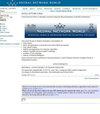Affective symptoms and postural abnormalities as predictors of headache: an application of artificial neural networks
IF 0.9
4区 计算机科学
Q4 COMPUTER SCIENCE, ARTIFICIAL INTELLIGENCE
引用次数: 0
Abstract
Chronic headache is a major liability in the individuals’ quality of life. Identifying in advance the main features common to patients with headache may allow planning a preventive strategy of intervention. An artificial neural network model (Auto Contractive Maps – AutoCM), aimed at analyzing the correlations between patients’ characteristics, affective symptoms and posture indicators has been developed in this paper. Patients suffering from chronic headache were observed at a neurological centre in Sicily (Italy). Headache and affective states were measured using the Profile of Mood States (POMS), the Beck Depression Inventory (BDI), the Toronto Alexithymia Scale (TAS-20) and the Repression Scale. Postural evaluations were carried through a stabilometric platform. The method of analysis selected allowed to reconstruct some records that were missing, through a Recirculation AutoAssociative Neural Network, and to obtain sound results. The results showed how some items from TAS-20, Repression and POMS were closely linked. The postural abnormalities were correlated primarily with repression features. The highest scores of the POMS were correlated with the items of the BDI. The results obtained lead to interesting remarks about the common traits to patients with headache. The main conclusion lies in the potentialities offered by the new methodology applied, that may contribute, overall, to a better understanding of the complexity of chronic diseases, where many factors concur to define patients’ health conditions.情感性症状和姿势异常作为头痛的预测因子:人工神经网络的应用
慢性头痛是影响个人生活质量的主要因素。事先确定头痛患者共同的主要特征可能有助于制定预防干预策略。本文建立了一种人工神经网络模型(Auto contraction Maps - AutoCM),旨在分析患者的特征、情感症状和姿势指标之间的相关性。在西西里岛(意大利)的一个神经学中心观察患有慢性头痛的患者。采用心境状态量表(POMS)、贝克抑郁量表(BDI)、多伦多述情障碍量表(TAS-20)和压抑量表对头痛和情感状态进行测量。通过稳定测量平台进行姿势评估。所选择的分析方法允许通过循环自动关联神经网络重建一些缺失的记录,并获得可靠的结果。结果表明,TAS-20中的一些项目,压抑和POMS密切相关。体位异常主要与抑制特征相关。POMS的最高分与BDI的项目相关。所获得的结果引起了关于头痛患者的共同特征的有趣评论。主要结论在于所采用的新方法所提供的潜力,总的来说,它可能有助于更好地了解慢性病的复杂性,其中许多因素共同决定了患者的健康状况。
本文章由计算机程序翻译,如有差异,请以英文原文为准。
求助全文
约1分钟内获得全文
求助全文
来源期刊

Neural Network World
工程技术-计算机:人工智能
CiteScore
1.80
自引率
0.00%
发文量
0
审稿时长
12 months
期刊介绍:
Neural Network World is a bimonthly journal providing the latest developments in the field of informatics with attention mainly devoted to the problems of:
brain science,
theory and applications of neural networks (both artificial and natural),
fuzzy-neural systems,
methods and applications of evolutionary algorithms,
methods of parallel and mass-parallel computing,
problems of soft-computing,
methods of artificial intelligence.
 求助内容:
求助内容: 应助结果提醒方式:
应助结果提醒方式:


